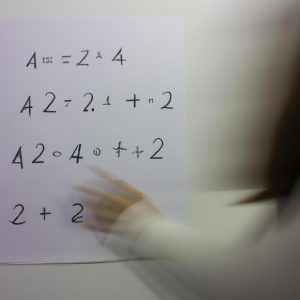Forces: Motion in Physics Directories

In the realm of physics, forces play a pivotal role in understanding and analyzing motion. The study of forces provides valuable insights into the behavior of objects in motion, enabling us to comprehend and predict their trajectories with precision. By examining various types of forces acting on an object, such as gravitational force or frictional force, physicists can elucidate the intricate dynamics underlying diverse physical phenomena.
Consider a hypothetical scenario where a tennis ball is struck by a racket. As the player exerts a force on the ball, it accelerates from rest to high speeds within seconds. This example vividly illustrates how forces are responsible for initiating and altering motion. Understanding the fundamental principles governing these forces is vital not only for athletes seeking to enhance their performance but also for scientists striving to unravel the mysteries of our universe through comprehensive models and theories.
The field of physics flourishes when we delve deeper into its intricacies, particularly when exploring the phenomenon of motion and its relationship with forces. Through meticulous analysis and experimentation, researchers have formulated laws that govern this dynamic interplay between objects and external influences. In this article, we will examine some key concepts related to forces in motion, including Newton’s laws of motion and factors influencing acceleration. By delving into these topics, readers will gain a better understanding of how forces shape the motion of objects and their impact on various physical systems.
Definition of Force
Definition of Force
Imagine a scenario where you are sitting in the comfort of your room, engrossed in reading a captivating book. Suddenly, a gust of wind blows through the slightly open window, causing the pages to flutter and turn. This simple example illustrates the concept of force – an external influence that can cause an object to move or change its motion.
In physics, force is defined as any interaction that can produce or modify the state of motion of an object. It is measured in Newtons (N) and is represented by vectors, which indicate both magnitude and direction. Forces act on objects constantly and play a fundamental role in understanding various phenomena in nature.
To better comprehend the significance of forces, it is essential to recognize their impact on everyday life:
- Physical interactions: When two objects collide or push against each other, forces come into play. For instance, consider a game of billiards where one ball strikes another with sufficient force to set it into motion.
- Gravity: One of the most familiar forces is gravity. It keeps us grounded on Earth and determines how objects fall when dropped from different heights.
- Friction: As we walk across surfaces or rub our hands together vigorously, friction opposes our movement. This force allows us to maintain stability while also generating heat energy.
- Tension: Imagine holding onto a rope tightly while someone pulls at the opposite end. The tension force within the rope transmits this pulling effect throughout its length.
Let’s further explore these forces through a table highlighting some common examples:
| Type of Force | Description | Example |
|---|---|---|
| Applied | A force exerted directly by an external agent | Pushing a cart |
| Normal | A perpendicular contact force between surfaces | Sitting on a chair |
| Spring | A restoring force exerted by compressed springs | Stretching a rubber band |
| Magnetic | Attraction or repulsion between magnetic objects | Two magnets attracting or pushing each other |
Understanding the concept of force provides a foundation for comprehending how objects interact within our physical world. In the following section, we will delve into various types of forces and their specific characteristics.
Transitioning to the subsequent section about “Types of Forces,” let’s explore further.
Types of Forces
Section H2: Types of Forces
Now, we will explore different types of forces that exist in nature. To illustrate this, let’s consider a scenario where an object is placed on a table.
- Contact Force:
One type of force acting on the object is called contact force. In this case, the table exerts an upward normal force on the object to support its weight against gravity. This force prevents the object from sinking through the surface of the table.
- Example: Imagine a book resting on a desk. The desk applies an equal and opposite force to counteract the gravitational pull on the book.
- Frictional Force:
Another important type of force is frictional force. When two surfaces come into contact and move relative to each other, friction arises. It opposes their motion and can be classified into two categories:
- Static Friction: This occurs when there is no relative motion between objects at rest.
- Kinetic Friction: This comes into play when there is relative motion between objects.
-
Gravitational Force:
Gravity plays a significant role in understanding various phenomena around us. Every object with mass experiences a gravitational force pulling it towards other objects with mass. This force depends on both masses involved and the distance between them. -
Applied Force:
Applied force refers to any external push or pull exerted by an agent onto an object. For instance, if you were to kick a soccer ball or push a car, these actions would result in applied forces being exerted on those objects.
To summarize:
| Type | Description |
|---|---|
| Contact | Exerted when two objects are physically touching |
| Frictional | Opposes motion between two surfaces |
| Gravitational | Attractive force between objects with mass |
| Applied | External push or pull exerted by an agent onto an object |
Understanding the different types of forces is crucial for comprehending motion in physics. In the following section, we will explore Newton’s Laws of Motion, which provide a framework for analyzing and predicting how objects move under the influence of these forces.
Newton’s Laws of Motion
Section H2: Forces: Motion in Physics Directories
Having explored the different types of forces, we now turn our attention to understanding how these forces affect motion. To illustrate this concept, let us consider a hypothetical scenario where a car is traveling along a straight road.
Motion and Forces:
In this scenario, as the car accelerates forward, several forces come into play, influencing its motion. Understanding these forces is crucial for comprehending the various aspects of motion in physics. Let us delve deeper into four key concepts related to forces and their effects on motion:
-
Balanced and Unbalanced Forces: When multiple forces act on an object in opposite directions with equal magnitudes, they cancel each other out, resulting in a state of equilibrium known as balanced forces. On the other hand, when one force dominates over others or acts alone on an object, it creates unbalanced forces that cause acceleration or deceleration.
-
Net Force: The net force acting on an object is determined by calculating the vector sum of all individual forces applied to it. This net force dictates whether an object will remain at rest or move with constant velocity or accelerate/decelerate.
-
Inertia: Inertia refers to an object’s resistance to changes in its state of motion. The magnitude of inertia depends on mass; greater mass leads to greater inertia. Consequently, objects with larger masses require more force to change their motion compared to lighter objects.
-
Action-Reaction Pairs: According to Newton’s third law of motion, every action has an equal and opposite reaction. This principle implies that any force exerted by one object onto another generates an equivalent but oppositely directed force back onto the initial object.
| Concept | Description |
|---|---|
| Balanced Forces | Opposite forces with equal magnitudes that result in equilibrium. |
| Unbalanced Forces | A dominant force causing acceleration or deceleration. |
| Net Force | The vector sum of all individual forces acting on an object. |
| Inertia | Resistance to changes in motion, determined by an object’s mass. |
Friction and its Effects on Motion:
As we explore the impact of friction on motion in our subsequent section, it is important to recognize how these concepts laid the foundation for understanding various aspects related to forces and their influence on objects’ trajectories.
Friction and its Effects on Motion
Section H2: Friction and its Effects on Motion
Expanding upon our understanding of motion as governed by Newton’s Laws, we now turn our attention to another key factor that influences the dynamics of objects in motion – friction. Through exploring the effects of friction, we can gain a deeper insight into how it shapes the behavior of various systems.
Friction is an omnipresent force that acts against the relative motion between two surfaces in contact. To illustrate this concept further, consider a scenario where a car is traveling along a road. As the driver applies the brakes to slow down, friction comes into play, converting kinetic energy into heat through resistance between the brake pads and rotors. This example highlights one instance where friction has tangible consequences on motion.
To comprehend the intricate relationship between friction and motion, let us delve into some key aspects:
-
Types of Friction:
- Static Friction: The resistance experienced when attempting to initiate movement.
- Kinetic (or Dynamic) Friction: The opposing force encountered during continuous motion.
- Rolling Friction: A specialized form affecting objects rolling over each other or on surfaces.
- Fluid Friction: Applicable to objects moving through fluids like air or water.
-
Factors influencing Friction:
- Nature of Surfaces: Roughness or smoothness impacts the degree of interaction.
- Normal Force: The perpendicular force exerted by a surface affects frictional magnitude.
- Surface Area: Greater area in contact increases potential for frictional forces.
- Coefficient of Friction: Material properties determine resistance levels.
-
Practical Applications:
Application Description Braking Systems Conversion of kinetic energy into heat through controlled friction Traction Enhancement Utilizing appropriate tire materials to maximize grip Safety Considerations Incorporating friction-based mechanisms to prevent slips and falls Engineering Design Considering frictional forces in designing structures for stability
Friction, as an essential component of motion analysis, unveils a multitude of phenomena that can be explored further. Understanding the various types of friction, factors influencing its magnitude, and practical applications enables us to comprehend how it shapes our everyday lives. Building upon this knowledge, we now proceed to explore another fundamental aspect of motion – momentum and impulse.
[Transition into subsequent section about “Momentum and Impulse”]: As we investigate the intricate relationship between forces and motion, delving into concepts like friction has laid the foundation for comprehending other significant components. One such element is momentum and impulse – crucial factors that will deepen our understanding of the dynamic nature of objects in motion.
Momentum and Impulse
In the previous section, we explored the concept of friction and its impact on motion. Now, let us delve further into another fundamental aspect of physics: momentum and impulse. To illustrate this concept, consider a scenario where a hockey puck is sliding across an ice rink. As it glides along, its inertia keeps it moving forward until acted upon by an external force.
Understanding momentum and impulse is crucial in comprehending how objects interact with each other during motion. When a force acts upon an object for a certain amount of time, it causes a change in the object’s momentum. This change can be quantified using the principle of impulse-momentum relationship: the product of force and time equals the change in momentum experienced by an object.
To deepen our understanding of these concepts, here are some key points to consider:
- Momentum depends on both mass and velocity. The greater an object’s mass or speed, the larger its momentum.
- Impulse is directly proportional to the change in momentum. A longer duration of force application results in a larger impulse.
- Conservation of momentum states that when two objects interact without any external forces acting upon them, their total combined momentum remains constant before and after the interaction.
- Elastic collisions preserve kinetic energy, whereas inelastic collisions result in a loss of kinetic energy as it is transformed into other forms such as heat or sound.
Let us now explore applications of force in everyday life to gain insight into how these principles manifest themselves beyond theoretical settings. By examining real-world examples, we can bridge the gap between scientific concepts and practical experiences, enhancing our comprehension of physics’ role in our daily lives.
Applications of Force in Everyday Life
Transitioning smoothly from the previous section on Momentum and Impulse, we now delve into the realm of Applications of Force in Everyday Life. To illustrate this concept, let us consider an engaging example involving a car collision.
Imagine a scenario where two cars collide head-on at high speeds. In such an event, various forces come into play, showcasing the practical applications of force in our daily lives. The impact generates significant forces that influence the motion and behavior of objects involved.
In understanding these applications, it is essential to explore how forces affect different aspects of everyday life. Here are some key points to consider:
- Forces in sports: Whether it’s kicking a soccer ball or swinging a tennis racket, athletes rely on the application of force to achieve optimal results.
- Structural stability: Engineers utilize forces when designing buildings, bridges, and other structures to ensure their stability under varying conditions.
- Transportation systems: From automobiles to airplanes, understanding forces allows for safer and more efficient transportation design.
- Medical interventions: Surgeons apply precise forces during procedures like bone realignment or joint replacements to restore functionality and improve quality of life.
To further grasp the significance of forces in diverse scenarios, let us examine them through the lens of a table:
| Application | Description | Impact |
|---|---|---|
| Sports | Athletes harness forces to enhance performance and achieve victories. | Improved skills |
| Engineering | Forces contribute to creating sturdy structures that withstand stress. | Enhanced safety |
| Transportation | Optimal force application ensures smoother travel experiences. | Efficient journeys |
| Medicine | Precise force application aids medical procedures for better outcomes. | Improved health |
By considering these examples and reflecting on the broader implications within each field, we begin to appreciate how fundamental an understanding of applied force truly is.
In summary, as we observe collisions between vehicles or witness athletes excelling in their respective sports, it becomes evident that forces play a crucial role in our everyday lives. Exploring the applications of force allows us to better comprehend and appreciate its impact across various domains. By recognizing these dynamics, we can develop innovative solutions, enhance safety measures, and improve overall well-being for individuals and society as a whole.








